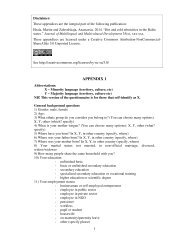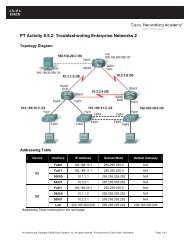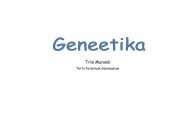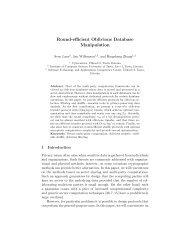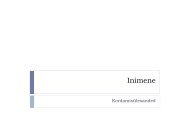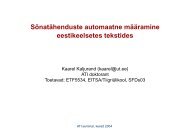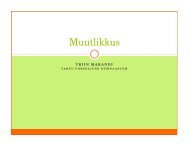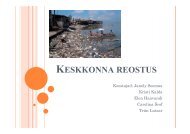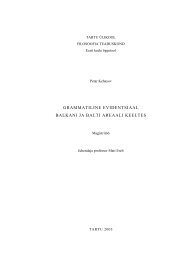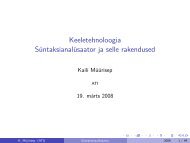Pragmapoetics as Literary Philosophyt ARNtr MERILAI
Pragmapoetics as Literary Philosophyt ARNtr MERILAI
Pragmapoetics as Literary Philosophyt ARNtr MERILAI
Create successful ePaper yourself
Turn your PDF publications into a flip-book with our unique Google optimized e-Paper software.
,iL!:1 i :<br />
tr,-<br />
<strong>Pragmapoetics</strong> <strong>as</strong> <strong>Literary</strong> <strong>Philosophyt</strong><br />
<strong>ARNtr</strong> <strong>MERILAI</strong><br />
<strong>Pragmapoetics</strong>: A Theory of Two Contexts (Merilai 2001,2003) is a<br />
study of figurative language usage <strong>as</strong> it informs literary texts.2 It also<br />
tries to contribute to our understanding of ordinary language usage.<br />
The term suggests a fresh disciplinary branch which is guided by the<br />
<strong>as</strong>sumption that poetic speech constitutes the object of analysis<br />
above all for a theory of poetics considering data provided by linguistic<br />
pragmatics. <strong>Pragmapoetics</strong> links Jakobsonian poetics with<br />
general semiotics: the study of syntax, semantics and pragmatics<br />
with an emph<strong>as</strong>is on the latter. It is primarily, although contingently,<br />
b<strong>as</strong>ed, on analytic language philosophy which offers sound<br />
advantages regarding methodological rigour and transparency<br />
extending <strong>as</strong> far <strong>as</strong> the possible affirmation of the Kantian postulate<br />
of grounding the research in logic, i.e. mathematics. While<br />
pragmapoetics explores the ontology of poetic utterances <strong>as</strong> a<br />
specific way of language usage, it forms, <strong>as</strong> a branch of language<br />
philosophy, the a priori philosophy of literature. Since it is<br />
concerned with the activity of the human mind in the contexts of<br />
fictionality, poetry, and the experience of beauty, it also belongs to<br />
t<br />
This article is b<strong>as</strong>ed on the paper "<strong>Pragmapoetics</strong>: A Theory of Two Contexts"<br />
presented on September 86, 2005 in Valencia, Spain at the 38th annual<br />
conference Formal, Functional and Typological Perspectives on Discourse and<br />
Grammar of the Societ<strong>as</strong> Linguistica Europaea (Merilai 2005a).<br />
Special thanks to my good friend professor Thom<strong>as</strong> Salumets from the University<br />
of British Columbia in Vancouver for his input.<br />
2<br />
The notion of pragmapoetics, a theory of poetic language usage, w<strong>as</strong> introduced<br />
by the author of this contribution <strong>as</strong> a parallel to the notion of pragmalinguistics,<br />
a study of language usage.
380 <strong>MERILAI</strong><br />
the philosophy of mind, and not only to aesthetics. Thus, it is my aim<br />
to contribute to our understanding of the way our mind works. More<br />
specifically, it is my contention that the properties of the poetic text<br />
reflect mental relations, or, <strong>as</strong> the creator of illocutionary logic,<br />
Daniel Vanderveken, put it " . . .. the logic of language use reflects the<br />
a priori order of thought" (1990:226).<br />
For the purpose of the poetics, pragmapoetics elaborates on<br />
theories of deixis (Karl Btihler, David Kaplan), speech acts (John L.<br />
Austin, John R. Searle, Daniel Vanderveken), implicatures (Paul<br />
Grice), discourse (Teun A. van Drjk), and fictionality (Gdrard<br />
Genette, Gregory Currie). An analysis of the poetic language usage<br />
shows that the common theories should be refined to describe speech<br />
of the higher type.<br />
It is <strong>as</strong>sumed that an utterance can perform several speech acts at<br />
a time (q.v. Searle, Vanderveken 1985), with respect to both<br />
referential and self-referential <strong>as</strong>pects. It is explicable by the concept<br />
of additional speech force F which is expressed, for example, by the '<br />
expressive <strong>as</strong>sertive EA(p), where the conditions for achievement of<br />
an additional expressive act, like the propositional content p or<br />
sincerity condition, some preparatory conditions etc, are partly<br />
satisfied by the primary <strong>as</strong>sertive act already. Thus, the poetic<br />
utterance Hopes are going to turn to rags (q.v. Appendix 1) by an<br />
Estonian poet Artur Alliksaar' can be formalised <strong>as</strong> an expressive<br />
<strong>as</strong>sertive E"o*praintAoerc;ption(p), in which the <strong>as</strong>sertive act can be<br />
understood <strong>as</strong> performed in full, while the expressive achieves a<br />
partial performance by using conditions partly fulfilled by the main<br />
act. Also, such concepts <strong>as</strong> macro-speech act, complex speech act<br />
and conversational implicature have to be considered.<br />
However, pragmapoetics focuses itself on the self-referential,<br />
more specificly on the poetic function of the language usage. What is<br />
linguistic self-referentiality? It is something that reveals itself rather<br />
t<br />
Artur Alliksaar (1923-1966) is a particularly appropriate choice since his<br />
extraordinarily imaginative free verse language poetry with its sonorous prosody,<br />
<strong>as</strong>sociative <strong>as</strong> well <strong>as</strong> paradoxical comical semantics, aphoristic, analytic<br />
and conversational properties provides an exceptionally representative and rich<br />
subject matter for both the study of poetics and language philosophy in general.<br />
clearly, for example,<br />
274).<br />
<strong>Pragmapoetics</strong> <strong>as</strong> <strong>Literary</strong> Philosophy 381<br />
in deictic activity (q.v. Figure 1, Merilai 2005b:<br />
deictic utterance, utterer<br />
Figure /. Deictic reference<br />
self-reference<br />
reference<br />
The two main characteristics of the deixis are: l) its explicit<br />
pragmatic context-dependency, and 2) its implicit semantic selfreferentiality.<br />
As John Searle exspresses it in his Intentionality<br />
(1991:221 ff):<br />
In uttering indexical referring expressions, speakers refer by means<br />
of indicating relations in which the object referced to stands to the<br />
utterance of the expression itself.<br />
So the expression 'I' refers to the person uttering that expression 'I'.<br />
'You' refers to the addressee of the person uttering the expression<br />
'you'. 'Here' refers to the place of the utterance of the expression<br />
'here'. 'Now' refers tq the time of the utterance of the expression<br />
'now'. "Yesterday" refers to the day before the utterance day of the<br />
expression 'yesterday'. And so on (q.v. Figure 2, Merilai 2005b:<br />
27 4).<br />
'I'd"f: refers to the person uttering the expression 'I'.<br />
'Now'6"1= refers to the time of the utterance of the expression 'now<br />
Figure 2. Deictic expressions
382 <strong>MERILAI</strong><br />
The utterance of indexical expressions, therefore, h<strong>as</strong> a form of selfreferentiality<br />
which is similar to the self-referentiality of certain<br />
intentional states and events (for example visual experience). In a<br />
word: deictic expressions are not only pragmatically demonstrative<br />
but also semantically fundamentally self-referential. More than that:<br />
one may <strong>as</strong>sume that deictics can function referentially only due to<br />
their b<strong>as</strong>ic self-referentiality which is therefore their most interesting<br />
peculiar feature. As a result the left side and the right side of the<br />
definition of the meaning of the indexical expressions overlap<br />
yielding a reflexive circulus vitiosus.<br />
Similar to deixis, the poetic expressions reveal strong selfreferentiality,<br />
too, only they foreground their linguistic qualities (i.e.<br />
similarities) more clearly and background thus their referential<br />
contents (q.v. Figure 3, Merilai... 2003:23,2005b:275).<br />
self-reference<br />
Figure 3. Poetic expressiona<br />
reference<br />
So it can be said by way of generalisation that language fulfils two<br />
main functions: referential and self-referential (q.v. Searle l99I:<br />
218-230), where the latter is usually an implicit, although especially<br />
characteristic of indexicality and rhetorics, the former an explicit<br />
one. Roman Jakobson (1960), of course, speaks of six functions, but<br />
these can be philosophically reduced to two: emotive, referential and<br />
conative to referential, poetic, phatic and metalingual to selfreferential,<br />
or poetic (q.v. Figure 4, Merilai... 2003: 22, 2005b: 27 5).<br />
a Translation of the expression: Scorchingly, the sun is shining.<br />
ff :iffi*.<br />
OT<br />
'<br />
l<br />
\<br />
\<br />
,<br />
ta<br />
dramatic<br />
I<br />
I<br />
I<br />
EMO TIVE ,,/-POETIC.".. CONATIVE<br />
l '<br />
<strong>Pragmapoetics</strong> <strong>as</strong> <strong>Literary</strong> Philosophy<br />
rcferential<br />
mimetic<br />
PI{ATIC<br />
METALINGUAL<br />
I<br />
self-referential<br />
poetic<br />
Figure 4. Referential and poetic functions<br />
383<br />
Considering poetics it seems to be clear that the expressive speech<br />
acts tend to satisff mainly the emotive function (i.e. lyrics), while the<br />
<strong>as</strong>sertives the referential one (epics), where<strong>as</strong> the directives and the<br />
commissives lay stress more on the conative role (dramatics).<br />
However, the most essential property of the art of poetry is certainly<br />
the fact that it poses self-referential function <strong>as</strong> primary, while the<br />
mimetic activity or the referential function recedes to a more<br />
secondary position. Literature boosts I inguistic se lf-referential ity that<br />
is relatively covert in ordinary speech, and turns the seemingly or<br />
actually referring utterances into an aim in itself, e.g. often shifting<br />
the attention from the content of the expression to the linguistic<br />
nafure of the expressions themselves.<br />
On the stylistic level of a poem (<strong>as</strong> opposed to the content level)<br />
the mutual referentiality of multiple phonetic, verbal, syntactic and<br />
semantic similarities takes place. This is essential to the parallelistic<br />
linguistic structures which the poems most genuinely are. It can be<br />
illustrated by the Figure 5 (Merilai...2003:36,2005b:2S0) where<br />
the rich mutual referentiality of linguistic equivalencies on different
384 <strong>MERILAI</strong><br />
levels in a single simple stanza of a poem by another Estonian poet<br />
Hando Runnel is well demonstrated5.<br />
'l<br />
ki<br />
mtnosvllabic<br />
beginnings (or ianb)<br />
Uks<br />
ladd<br />
sest<br />
ja<br />
lci. et<br />
lci- 0, v4-<br />
ki- ki- vid ku-<br />
Figure 5. Poetic self-referantiality<br />
te<br />
t0<br />
J'-<br />
lu<br />
unstressed wllables (1, 3, 5, 7)<br />
II<br />
alliteration ossonance repetition of svllables,<br />
hi- ,-id ku-<br />
VA- .Jt:<br />
me aningful ac c um u lati o*<br />
lontt votvel<br />
s Translation of the stanza: A mitl stands upon the waters / but no millwork is<br />
being done there / <strong>as</strong> the millman is tired / and the millstones are dull. (Hando<br />
Runnel, *A Mill Stands upon the Waters", 1972.)<br />
<strong>Pragmapoetics</strong> <strong>as</strong> <strong>Literary</strong> Philosophy 385<br />
It may be tempting to call this kind of poetic auto-referentiality<br />
among the linguistic and semantic equivalencies also deictical but it<br />
would be a mistake. Deixis does not work everywhere, pandeictically,<br />
instead the more b<strong>as</strong>ic self-referential function of<br />
language reveals itself in different ways, either deictically or nondeictically.<br />
Not everything self-referential in language usage is<br />
automatically deictical, there is no such implication. On the contrary:<br />
one may claim that everything mutually reflexive in language is also<br />
poetical, at le<strong>as</strong>t implicitly. Both phenomena have fundamental selfreferentiality<br />
in common which is therefore a more general and<br />
deeper feature of the language they reflect. This is why the selfmanifestation<br />
of the poetic expresSions looks pretty much like<br />
discourse deixis and vice versa: although stemming out of the same<br />
root, they are certainly different.<br />
So, in addition to the previous analysis of the EA(p) poetic speech<br />
act with its additional force, the possible rhetorical speech forces of<br />
the Lotmanian secondary modelling system (e.g. Iloruau 1972: 18-<br />
23) have to be taken into account. A central idea of <strong>Pragmapoetics</strong><br />
consists of a model of the two contexts of literary perception: the<br />
<strong>as</strong>pect of the content, or the narrow context, and the <strong>as</strong>pect of the<br />
expression, or the broad context - single utterances but two levels of<br />
perception, of meaning and force (q.v. Figure 6, Merilai 2001: 166,<br />
2003: 223,2005b: 281).<br />
de dicto / de se <strong>as</strong>pect ofutterance<br />
actual discourse deixis<br />
Figure 6. One utterance, different speech acts<br />
a<br />
de re <strong>as</strong>pect ofutterance<br />
frctiornl physical deixis<br />
According to <strong>Pragmapoetics</strong>, all linguistic communication takes<br />
place on two contextual levels simultaneously (probably a tacit
386 <strong>MERILAI</strong><br />
Fregean idea). In the narrow, or linguistic-semantic context, the type<br />
of the utterance is interpreted generally, against the background of<br />
possible worlds, while in the broad, or semantic-pragmatic context,<br />
the particular meaning gets fixed according to the actuality (q.v.<br />
Figure 7 ,Merilai 2001 : 167 ,2003: 223,20A5b: 282).<br />
BROAD CONTEXT<br />
NARROW CONTEXT<br />
Internal content and form, implied author<br />
Fiction, imagined reference and belief (beliefl)<br />
VirtuaUnon-vrrtual de re deixis and speech acts<br />
External/expressional content and form, real author<br />
Actuality, scepticism towards beliefr, actual belief (belief2)<br />
Actual de dicto / de se self-defeating speech acts<br />
Poetic self-referentiality, discourse deixis<br />
Figure 7. Perceptional <strong>as</strong>pects of literature<br />
So, when somebody calls out "A wolf's coming!", we all know the<br />
general meaning of the utterance. But its particular meaning becomes<br />
clear only in the actual situation: it may be true at a dangerous wolfhunting<br />
event in the forest, but it may be just an innocent game of<br />
make-believe at a wild-goose ch<strong>as</strong>e with the kids in the park. Hence<br />
there are two simultaneous contexts, the general and the particular. In<br />
this instance, it is a matter of survival not to confuse the two: it is of<br />
utmost importance to know whether one's father is smiling or<br />
winking his eye (the rhetoric speech force markers) while saying "A<br />
wolf s coming!" or really trying to escape in panic.<br />
<strong>Literary</strong> discourse clearly explicates the difference of the levels,<br />
by practising the imaginative referential function in the former (often<br />
<strong>Pragmapoetics</strong> <strong>as</strong> <strong>Literary</strong> Philosophy 387<br />
in a self-defeating, fictional or rhetorical manner); <strong>as</strong> well <strong>as</strong><br />
ampliffing the self-referential function of language in the latter, a<br />
real rhetoric context of the author and the reader. It is very important<br />
that the audience does not run onto the stage to save Othello and<br />
Desdemona from their dire straits or to ch<strong>as</strong>tise Harpagon, although<br />
some people whose personal pain is actually touched by the situation<br />
would like to stop the play. But it remains still a play ffid, <strong>as</strong><br />
grownups, they recognise, what is an illusion and what is real. It is<br />
common intuition that the story is brought forward via a fictional<br />
author who is neither the intradiegetic narrator nor the actual author,<br />
or the producer using the actors to perform a text, but an<br />
extradiegetic construct between the narrow and the broad contexts<br />
implied by the audience - a well-informed, more or less imaginary<br />
mediator who is forwarding the event immediately unravelling in<br />
front of the spectator's eyes. This is just imagined. On the broad<br />
plane, however, the composition of the story, the absorbed acting and<br />
expression of the perforrners is observed. It constitutes an attempt to<br />
participate in a dialogue with Shakespeare, Molidre, or the producer<br />
of the utterances. In c<strong>as</strong>e of the arts it is even 'ogood" if the truth or<br />
success of an utterance in the nanow context does not p<strong>as</strong>s the test of<br />
reality, which shows that something else h<strong>as</strong> been striven for than the<br />
referential de re speech: the shift of attention from the content of the<br />
expression p - with its narrower de dicto environment - to its<br />
stylistic and artistic nature de se.<br />
As a result the picture, <strong>as</strong> it may be outlined, forms itself<br />
eventually <strong>as</strong> tripled (q.v. Figure 8).<br />
R<br />
tl<br />
Fi p :<br />
II<br />
Figure 8. Imaginative speech act in rhetorical context
388 <strong>MERILAI</strong><br />
The secondary modelling system that h<strong>as</strong> concentrated around the<br />
poetic function enters the horizontality of ordinary language usage<br />
on the vertical axis, where<strong>as</strong> the secondary (or self-referential)<br />
becomes the main aim and therefore primary; the usually primary (or<br />
referential) can be made virtual and therefore it remains secondary -<br />
a spring-board, a stage prop, although not only that. The matter of<br />
the content, whether Anna comes to a happy end or ends up under a<br />
train, is an important inductive b<strong>as</strong>is to this theory; however, the eyes<br />
of a deductivist literary scholar e<strong>as</strong>ily tend to glide over this level in<br />
favour of stylistics and can thus be mistaken for the detriment of the<br />
holistic whole.<br />
Thus: in the narow scope, the sincerity condition is reduced to<br />
imaginary belief, or make-belief; in the broad scope, to actual one,<br />
the relation of which to the former may often be sceptical. The<br />
spontaneously transgressible boundary between the two contexts, or<br />
<strong>as</strong>pects of the perception, with them also merging into each other, is<br />
signified by the symbol for the caesura //. So the complex utterance<br />
can be described with the help of formulae such oS R*"1uo1,or(icar hyperbore),<br />
^.o'r,""//EA(p) or R."1"01,o(icar hyperbol"), <strong>as</strong>son*""//EA(p)...Rmnv(9) where<br />
the possible ironic or sarc<strong>as</strong>tic implicatum of the narrow context<br />
Rronr(g) (which is, of course, also an anticipated trope on the broader<br />
level) may perhaps once hint at a meaning like 'the Soviet life makes<br />
everything sordid' or something close to that. Attention shifts<br />
spontaneously between de re and de dicto / de se <strong>as</strong>pects of the<br />
poetic utterances, in which the imagined belief (or beliefl) is<br />
constantly alternating with the actual belief (or belief2). The analogue<br />
would be Louis Necker's psychophysical cube from Wittgenstein's<br />
Tractatus (1996: 5.5423) and the drawing of the rabbit/duck from his<br />
Philosophical Investigations (2005: II, xi) with its Aufleuchtung,<br />
fl<strong>as</strong>hing up of its perceptual <strong>as</strong>pects (q.v. Figure 9). Such mental<br />
roundabout traffic could be called a game of literary or artistic makebelieve.<br />
Figure 9. One expression, two objects<br />
<strong>Pragmapoetics</strong> <strong>as</strong> <strong>Literary</strong> Philosophy 389<br />
Thus, the theory is concerned with poetry and fiction operating<br />
simultaneously <strong>as</strong> a two-faced Janus around the borderline of two<br />
contexts: in the narrow one or in the world of make-believe inside a<br />
text (that at times can coincide with actuality but not necessarily),<br />
and, in addition, in the broad scope or the world of the actual belief<br />
of the author-text-reader. The speech force of the broader level is not<br />
applicable to the proposition <strong>as</strong> it is in the narrow context, but h<strong>as</strong> the<br />
whole speech act of the narrow scope <strong>as</strong> its object: not simply p <strong>as</strong> de<br />
re but rather EA(p) <strong>as</strong> de dicto, or Rmetapho(ical hyperbole),<br />
*roo-""//EA(p)[...Ai,""v(q)] in its entirety <strong>as</strong> de se. Thus, the secondary<br />
(and clearly partial) speech act of the broad context can rather be<br />
described according to the principles of de dicto and de se - about<br />
itself, about its expressionai qualities - than de re speech. The sense<br />
of the first level, Sinn, through which the reference, Bedeutung, is<br />
achieved, becomes itself the content on the second level and the<br />
reflexively indicated - obviously a Fregean idea (q.v. Frege lSgZ).<br />
Precisely the meaning of expressions is the content of art and its real<br />
object, the real indication; references to the actual world <strong>as</strong> an aim<br />
become virtual, or at le<strong>as</strong>t made secondary. So the actual content of a<br />
poem is not, or is not only, its particular content (<strong>as</strong> a string of the<br />
propositions or their summary), but rather the way this content is<br />
linguistically presented, its form and style. Expression itself becomes<br />
a content.<br />
To sum up: the hypothesis of the two contexts seems to have a<br />
good explanatory power. According to it, poetic activity is con-
3gO MEzuLAI<br />
centrated around two elliptical centres: single utterances, but two<br />
centres of force, content and contexfual orientation. One should learn<br />
to follow the game <strong>as</strong> it is not an inborn capability, but rather a<br />
sophisticated system of cultural conventions, i.e. higher language<br />
games. Slowing down the process of everyday reception, its defamiliarisation<br />
is the very nature of the aesthetic <strong>as</strong> h<strong>as</strong> been claimed<br />
already by the Russian formalists, especially Victor Shklovksy.<br />
In everyday communication it is referentiality that rules. However,<br />
poetic discourse reveal explicit linguistic self-referentiality.<br />
Poetic expression is more complicated than ordinary speech, a<br />
language usage governed by numerous artificial restrictions that is<br />
sometimes referred to <strong>as</strong> a secondary modelling system above the<br />
primary one. These hundreds of restrictions, i.e rules and devices of<br />
the artistic style (<strong>as</strong> well <strong>as</strong> the rules of breaking old rules), created<br />
throughout the centuries, ffa all more or less explicitly selfreferential<br />
by nature: art boosts expressional self-referentiality. At<br />
le<strong>as</strong>t in literature, "The most important is the game," <strong>as</strong> one of the<br />
titles by Artur Alliksaar declares.<br />
The deep sources of explaining language, mind and art lie in<br />
poetry, literature and the analysis of these. Linguistics and language<br />
philosophy without poetics do not make always sense, just lik€<br />
poetics does not make sense without them - it is not only Roman<br />
Jakobson or Juri Lotman (or even Martin Heidegger with his Stiftung<br />
by the poetic declarations) who present this opinion. However<br />
splendid it would be to clear up all the beautiful ways of autoreferentiality-al<strong>as</strong>,thereisnopropermathematicsyet.<br />
References t<br />
Frege, G. 1892. Uber Sinn und Bedeutung. - Zeitschrrftft, Philosophie und<br />
philosophische Kritik,Neue Folge, Bd. 100: 25-50.<br />
Jakobson, R.1960. Closing Statement: Linguistics and Poetics. - Style in<br />
Language, ed. by Thom<strong>as</strong> A. Sebeok, 35V377 (New York: The<br />
Technology Press of M<strong>as</strong>sachusetts Institute of Technology and John<br />
Wiley & Sons, Inc.).<br />
<strong>Pragmapoetics</strong> <strong>as</strong> <strong>Literary</strong> Philosophy 3gl<br />
Jloruau, IO.l972 Auaaus noomuvecKoeo meKcma. Cmpyxmypa cmt&q.<br />
JIeHv Hrpag : I,IsAarenbcrBo llpo ceeqeHue.<br />
Merilai, A. 2001. Poetic Speech Acts: A Hypothesis of Two contexts. -<br />
Trames: Journal of the Humanities and Social Sciences, 2, vol. 5<br />
(55/s0): 157-176.<br />
Merilai, A.2003 Pragmapoeetika: Kahe Konteksti Teooria. Tartu<br />
University Press.<br />
Merilai, A. and A. Saro, E. Annus.2003. Poeetika: Giimna<strong>as</strong>iumidpik.<br />
Tartu: Tarfu University hess.<br />
Merilai, A. 2005a. <strong>Pragmapoetics</strong>: A Theory of Two Contexts. - SLE 2005:<br />
Formal, Functional and Typological Perspectives on Discourse qnd<br />
Grammar : Abstracts. Valencia, Spain.<br />
Merilai, A. 2005b. Regarding <strong>Pragmapoetics</strong>: Deixis. Lausungist<br />
lausumiseni ja v<strong>as</strong>tupidi. Multidistsiplinaarsed vaated deiksisele. De<br />
l'dnoncd d I'dnonciation et vice versa. Regards multidisciplinaires sur la<br />
deixis. From utterance to uttering and vice versa. Multidisciplinary<br />
views on deixis. Ed. by Daniele Monticelli, Renate Pajusalu, and Anu<br />
Treikelder. Tarfu, Estonia: Tartu University Press 271-285.<br />
Searle, J. R. l99l Intentionality: An Essay in the Philosophy of Mind.<br />
Cambridge: Cambridge University Press.<br />
Searle, J. R., and D. vanderveken. 1985 Foundations of lllocationary<br />
L o gi c. Cam bridge : Cambridge Univers ity Press.<br />
Vanderveken, D. 1990 Meaning and Speech Acts, vol. 2, Formal Semantics<br />
of success and satisfaction. cambridge: cambridge University Press.<br />
Wittgenstein, L. 1996. Loogilis-Filosoofiline Traktaat. Tractatus Logico-<br />
P hilos ophicus T artu: I lmamaa.<br />
Wittgenstein, L. 2005 . F il os oofi I is e d uurimus e d. Ilmamaa.
^, -s;..<br />
392 <strong>MERILAI</strong><br />
Appendix I<br />
ARTTJR ALLIKSAAR (te23 - 1966)<br />
WHERE TO,<br />
wHRE TO,<br />
UGH!!!<br />
Time-tables.<br />
Hail-tables. . ,<br />
Gain-tables.<br />
Are the-.trains still going to hurry to the parties of st'kingly struggling joys? !<br />
Breath-nets.<br />
Heat-nets.<br />
Death-nets.<br />
fue the shirs still going to spray the blue sparks of qpring?!<br />
Hopes are going to tum to rags.<br />
It doesn't matter - i.ve'll sew the m up with the thread of dreams stolen from the bushels of midnight.<br />
The charm rs going to grow thinner.<br />
It doesn't matter - it can't vanish anywhere from the tight tin cup of our tribulations.<br />
Yet the spell is really going to fadel<br />
With more tension and greater gulps let us drLnk then its dusky brightressl<br />
The soul is worn to holes like a prehrstoric engine.<br />
.Never mind - we wili race forward in a canoe carved ortr of the trunk of the futrue-tree.<br />
You, wind, are a very frolicsome insect indeedl<br />
For ever with us, ch<strong>as</strong>ers of captivations, for ever with us, hackers of tansfigurations.<br />
Never falhng behind.<br />
Look, how many pretend to be dumbl<br />
Look, how respectably they make fools of themselves!<br />
Loolg how benightedness is bo<strong>as</strong>ted aboutl<br />
Look, how many take muck for marmaladel<br />
You can understand everythrng because you can.lumble up things, in order to put them in proper order.<br />
A fly is walking on the time-table and believes it is rr Bergen andBerlin and Baku<br />
There is no moment when no one feels killed.<br />
There is no moment when no one reache s out for an embrace.<br />
There is no moment when no one is on the road.<br />
Go ahead, go ahead, go ahead wrapped in the clouds of the dandelion-fluffs of your wrsh-dreamsl<br />
The branching out of fingers and toes, of thoughts and memories h<strong>as</strong> neither begiming nor end.<br />
Translated bv A. Merilai and Ene-Reet Soovik<br />
I I,*"<br />
$:<br />
l<br />
I<br />
f
iffinlittcrerir<br />
Tartu Olikooli maailmakirjanduse \ppetooli ja Eesti Vdrdleva Kirjandusteaduse<br />
Assotsiatsiooni rahvusvaheline a<strong>as</strong>tukiri.<br />
Annual international refereed edition of the Chair of Comparative Literature of l<br />
Tartu (Jniversity and the Estonian Association of Comparative Literature.<br />
Edition annuelle internationale de la Chaire de Littdrature Comparie de l'Universitd<br />
de Thrtu et de l'Association Estonienne de LifiArature Companle.<br />
Internationales Jahrbuch des Lehrstuhls fi)r Weltliteratur an der Universittit Tartu und<br />
der Assoziation der Vergleichenden Literaturwissenschaft in Estland.<br />
Edici6n anual international de la Catedra de Literatura Comparada de la Universidad<br />
de Tartu y de la Asociaciiln Estonia de Literatura Comparada.<br />
Toimetuskolleegium/Editorial Board:<br />
Ji)ri Talvet (toimetaja/editor), Pilvi Rajamtie, Tiina Aunin (abitoimetaiad/<strong>as</strong>sistant editors),<br />
Eduardo Coutinho, Dorothy Figueira, Gerald E. Gillespie, Marina Grishakova,<br />
Reet Sool, Monica Spiridon, Kersti Unt<br />
Aadress/Address:<br />
INTERLITTERARIA, Thrtu Olikool, maailmakirjanduse Sppetool, 50090 Thrtu, Estonia<br />
te t. (ax: + 3 7 2 7 3 7 5 3 5 0, e-mail : talvet@ut.ee ; website : www.ut' ee/inlit<br />
Kirj<strong>as</strong>taja ja levitaja/Publisher and Distributor:<br />
Turu 0likrxtli Kirj<strong>as</strong>tus/Tartu (Jniversig, Press, Tiigi 78, Tartu 50410, Eesti/Estonia<br />
tel.: +372 737 5945, /'ax: +372 737 5944, e-mail: tyk@ut.ee, website: www.tyk.ee<br />
K u.i und:tj a/Designer:<br />
Lanni Koni<br />
\<br />
Copyright 2007 by Tartu University Press<br />
Printed and bound by Tartu University Press' Order No- 196<br />
unterlnmnnnfi<br />
| 2 -2007<br />
TARTU ULIKOOLI<br />
KIzuASTUS



